MARCH
According to the early Roman calendar, March was the first month of the year and was called Martius in honour of the God of Mars. The ancient Romans later made January 1 the beginning of the year, and March became the third month on the calendar.
AS MAD AS A MARCH HARE!

As Mad as a March Hare, first appeared in Chaucer's Friar’s Tale, in the 14th century. It is derived from the fact that March is the rutting time of hares, when they are excitable and violent.
At this time of year hares can be seen in broad daylight chasing one another around meadows. During this spring frenzy, hares can be seen "boxing"; one hare striking another with its paws. For a long time it had been thought that this was more inter-male competition, but closer observation has revealed that it is usually a female hitting a male; either to show that she is not yet quite ready to mate, or as a test of his determination.
The best time to see this unique event is early in the morning, generally in open fields but they are known to be less cautious and will sometimes "perform" in places much closer to human habitation.
IN LIKE A LION AND OUT LIKE A LAMB!
In like a lion, out like a lamb, is one of our most familiar weather proverbs. It refers to the fact that the month of March begins with cold wintery winds, only to be replaced by Spring as it leaves us.
The March wind roars
Like a lion in the sky,
And makes us shiver
As he passes by.
When winds are soft,
And the days are warm and clear,
Just like a gentle lamb,
Then spring is here.
- Author Unknown
ST. PATRICK AND THE SHAMROCK
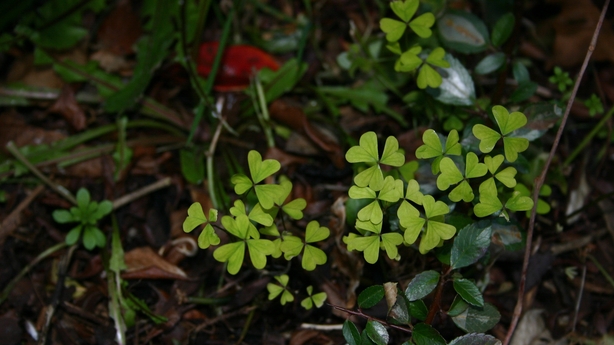
Legend has it that St. Patrick picked a small, green, three-leaved plant to explain the Christian concept of the Trinity to the Celts he had been sent to Ireland to convert. But what plant did he pick? It could have been one of many different plants, and maybe not even a shamrock!
Many argue that the original shamrock was a clover. A variety of white clover — the same species you probably have growing among the grasses in your lawn — is even sold in small pots every year specifically to celebrate St. Patrick's Day.
It may even have been an Oxalis, or wood sorrel. If you look at most drawings of shamrocks, they have leaflets that are heart-shaped. The leaflets of common clovers are round. The leaflets of wood sorrel ·are heart-leaved.
We will probably never know exactly what plant it was that St. Patrick used. At that time, all little three-leaved plants were called seamrags.
He may have even have picked both clovers and wood sorrels, whichever was close by when he needed it!
Keep an eye on whatever shamrocks you see on March 17, and you can decide for yourself whether your favourite is a clover or a wood sorrel — or maybe another three-leaved plant altogether?
ST. PATRICK AND SNAKES
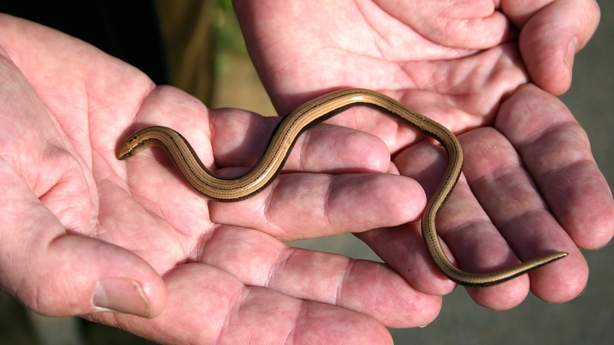
St. Patrick drove all the snakes from Ireland - or did he?
When the last ice age ended, Ireland was still connected to Britain by a land bridge, and the whole landmass was still connected to Europe. As the ice melted, the sea level rose, first submerging the land bridge to Ireland and only later the land bridge where the English Channel now is. By the time snakes had slithered their way northward from Europe into Britain, Ireland was already an island. Hence, Britain has wild native snakes and Ireland doesn’t.
One animal that you may come across if you are in the Burren region of Co. Clare is the slow worm. Although a legless lizard, it looks more like a snake. It can be told from a snake by its eyelids which can be closed and the fact that it can shed the end of its tail if captured by a predator. It is believed that they were introduced to the Burren about 40 years ago and you might be lucky enough to see one basking itself on a summer’s day. Don’t be fooled by it’s name. It is not slow. When disturbed, it can run at great speed across the rocks away from you.
DAFFODILS? NO THANKS!
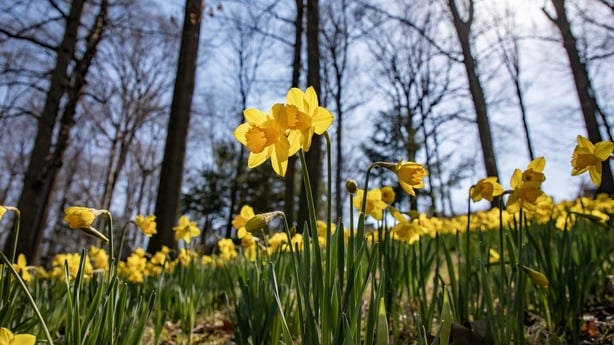
Have you ever wondered why there are so many daffodils in our woodlands. At this time of year, food is still scarce for our woodland mammals and you would think that daffodil bulbs would make a tasty meal for rabbits and deer.
Fortunately for gardeners, Daffodils are near the very bottom of their list of food preferences. Their leaves and bulbs actually contain toxic alkaloids that deer, rodents and most other creatures avoid. Today, daffodils come in a wide range of flower forms and colours, with bloom times that span a month or more. You can plant plenty of these early spring beauties and be relatively confident that they won't be eaten.
It has been said that the daffodils in flower in Dunsink Observatory in Dublin may have inspired William Wordsworth to write his famous poem. Wordsworth was friendly with William Rowan Hamilton, one of the world’s most brilliant mathematicians and Ireland’s greatest scientist and visited him in Dunsink.
NATIONAL TREE WEEK:
National Tree Week will take place from 19-26 March this year. Tree Week is sponsored by Coillte and this years theme is "Biodiversity begins with Trees".
By doing something as simple as planting a tree, everyone can play his or her part in helping the environment. By thinking locally, we can act globally!
The aim of National Tree Week is to raise awareness about trees and encourage local communities and local authorities to participate in over 300 events which will take place around the country during the week. Events include forest walks, tree planting ceremonies, workshops, talks, competitions and even tree plantathons! An events guide is available. You may pick up a copy at any Coillte office or O2 outlet around the country. (Click here (http://www.treecouncil.ie/Modules/Events%20NTW%202006.doc)
to download word document of events). The events are free and everyone is welcome to attend.
FROGS:
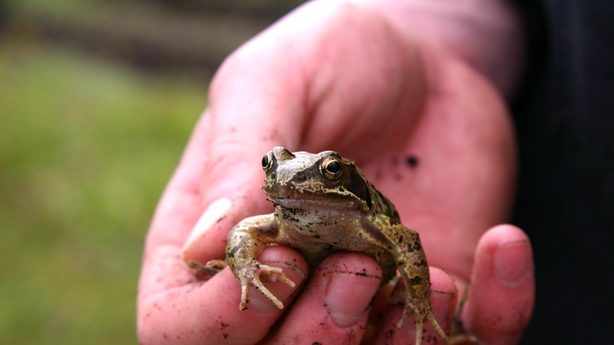
Frogs are amphibians, that is they can live and breath in water and in air. Most live in damp places, near pools and streams, because they need to return to water to breed.
At this time of year you will come across frogspawn or tadpoles in pools, ditches or drains around the country.
The Irish Peatland Conservation Council (IPCC) need your help in mapping all those areas with with frogs present.
The "Hop to it Irish Frog Survey" was set up in 1997 to try and get as much data as possible on our only frog species, the Common Frog, (Rana temporaria) - from the Latin, Temporary frog, as it was only seen in Ireland at certain times of the year - Did you know also that frogs have been recorded in every county in Ireland.
Even if you live in an urban or suburban area, you could still have frogs in your garden, especially if you have a garden pond. Garden ponds have become very important habitats for the common frog. Further information and sighting cards can be had from The IPCC, Lullymore, Co. Kildare or visit the website at www.ipcc.ie
FEEDING GARDEN BIRDS
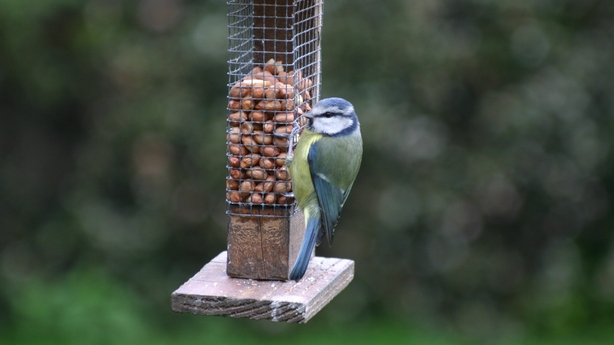
When should we stop feeding garden birds, or can we continue to feed throughout the summer? This question has been asked many times recently and opinion varies.
Most of us feed the birds throughout the winter and this brings us great enjoyment, watching small blue tits hanging upside down on the nut feeder or the the solitary robin hopping across the lawn. Also at this time of year, ivy fruits are a good source of food for the birds. And unusually, ivy fruits are black! Keep an eye out for them if you are out walking.
At this time of year, with day length increasing, many birds will be thinking about pairing off. You will notice the males of many species are looking splendid in their plumage while the females still have that drab look about them.
Why is it that the males should look so well? In biology, it is referred to as sexual dimorphism. Males are bright and showy in order to attract a female. Females need to sit on eggs. A bright colouration would be a giveaway, so they have drab colours to blend in with the surroundings. Think of the male and female pheasant or chaffinch. These are good examples.
But how do they attain these magnificent colours. Blue tits have yellow breast feathers. To maintain this colouring, they need to eat certain caterpillars that consume carotene loaded
plant leaves. The more of these caterpillars they eat, the more intense is the yellow colouration. Females tend to choose mates with the brightest yellow breast feathers.
DANDELIONS:

Dandelions come into flower this month. The name dandelion is a corruption of the French words dent de lion or "lion’s tooth". This refers to the pointed lobes of the plant’s leaves. The other French name for this plant is pis-en-lit, which means "wet-the-bed" in English. This plant has many local names throughout the country, including "wet the bed" or "piss-in-the-bed". This has led to the widely held children’s belief that picking dandelions caused bed-wetting! However, it is now known that the plant does indeed contain chemicals commonly referred to as diuretics (chemicals that cause^ increased urination in the body!). In fact, dandelion root is a registered drug in Canada, sold as a diuretic.
GARDEN NEST BOXES:
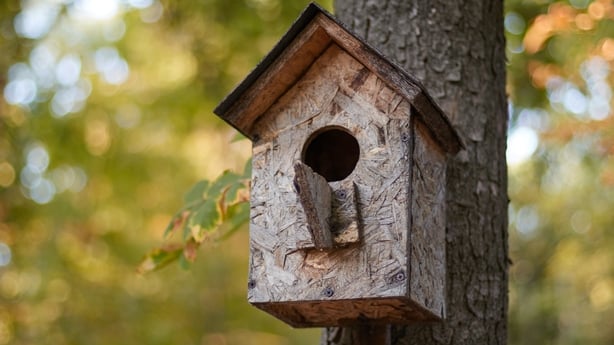
Time to give a last quick look over your garden nestbox to check that it is still in position and that there is a clear flight path to its opening. Be careful though, as some birds are already checking out prospective homes and may already be in residence. Make sure to remove any new growth that may be blocking the entrance or flight path to the nestbox entrance. Birds are more likely to abandon nests early in the breeding season than later, so be careful.
Look out for unusual nesting sites in your garden. Robins will often nest in old flower pots or even a discarded kettle!
Leave out an old hanging basket with pieces of twine, fluff clumps of moss etc. Small nesting birds will take these to line their nests with.
